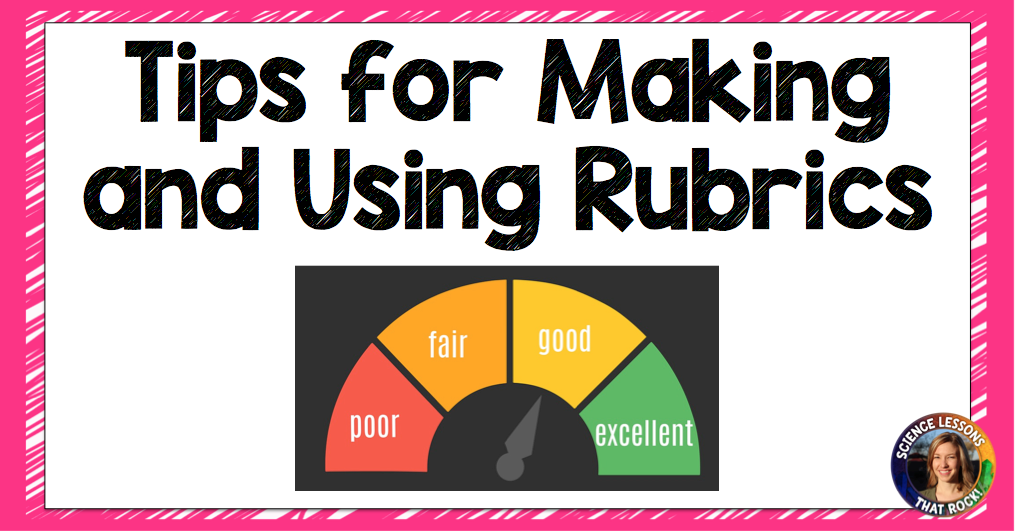Fast forward to 2015 when I began teaching a course that was taught entirely via PBL (project based learning). PBL is a very fluid and flexible way to teach- you pose students a question and tell them what the final product will be, but the pathway to accomplish the product can look very different from student to student. (If you would like to read more about the PBL process, check out this blog post). Since rubrics were essentially a new grading tool for me, I had quite a learning curve ahead of me. Confession: I still don’t love making rubrics, but I’ve learned how valuable they can be for both students and teachers. After using them for a few years now, here are some things I’ve learned:
WHY USE RUBRICS?
- As I’ve already mentioned, rubrics are great for PBL or any mode of teaching that is student- driven. This allows them to see your expectations and find their own way to meet them.
- As a science teacher, grading lab reports can take HOURS. Using a rubric can save you major time. Instead of leaving comments all over their paper, just circle elements on the rubric.
- Rubrics give specific feedback to students. They can see exactly where they fell short and what they need to improve.
- Rubrics allow for student creativity/flexibility (more on this in the next section).
- Rubrics allow for unbiased grading. They either met the criteria or they didn’t. No favoritism.
- Administrators asking how your lessons are aligned to standards? Easy. Show them how your rubric incorporates NGSS or common core learning targets.
- Rubrics set clear teacher expectations. No more “but I didn’t understand what to do.” Students have the criteria laid out for them.
Ready to make some rubrics? Here are some tips:
TIPS FOR MAKING RUBRICS
- Don’t fill out every box. It is okay to leave some boxes blank! Why? Leaving the exceeding box blank allows students to think above and beyond. Alternatively, some teachers may choose to leave the poor/lowest category blank. Why spell out what bad student work looks like?
- Be specific. Be sure to include the specific learning targets and objectives you want students to meet or learn. While there are many different pathways to get there or different ways to demonstrate their knowledge, they need to somehow show you that they met that standard.
- Try having students co-create the rubric. Sometimes students feel like they have no say in what they learn or accomplish. Allowing them to create the rubric with you gives them a voice and also holds them accountable to their own standard.
- Use student-friendly language. If students don’t understand what they need to do in order to meet the standard they may turn in work that is not aligned to your expectations. Use vocabulary they understand and go over the rubric with them.
- Grade a sample together as a class. (If you’ve given the assignment more than one year in a row, save a student work sample or two. If not, create your own sample). When students can see a sample and assess it as a class, it really helps clarify your expectations. I know what you are thinking… because I thought it too. “If I show students a sample, they will just copy it.” You can avoid this by:
- Don’t choose a stellar example. Show them what a mediocre assignment looks like and they can brainstorm ways they could improve upon it.
- Choose a different topic. If you are assigning a lab report on heat transfer, it is perfectly acceptable to show them a sample lab report on a different topic and have them critique it. Chances are your lab report rubric is the same each time, so the expectation is the same no matter the topic.
- Give the students the rubric PRIOR to starting the project or assignment. I’ve been guilty of not having the rubric completed prior to starting the project or lab and scrambling to come up with a rubric at the end. This in no way helps the students. They need to know what the grading criteria are prior to turning in the assignment.
- Use the rubric as a formative assessment tool. Don’t have students wait until the end to look at it! Halfway through the project or assignment have students check in. Are they meeting the criteria? You can have them self assess or do a peer assessment so they can see what to improve on before it gets to you. This should greatly increase the quality of their work and save you grading time later.
- Want to save even more grading time? If you graded their drafts with the same rubric, have them turn in the draft rubric along with their final copy. That way you can just focus on the areas of improvement and skip over the areas they already did well on.
FREE WEBSITES FOR RUBRIC CREATION
While you can use Microsoft word to make rubrics, there are websites out there that make the process easier. Two sites I like are:
- Rubistar: Create a free account on Rubistar and it will save all your rubrics for you. You can even search for rubrics by topic and use rubrics that have already been created by other teachers.
- Theme Spark: Create a free account on Theme Spark. It not only saves your rubrics but already has standards built in! Create a standards based rubric in minutes your administrator will love.
Have any more rubric tips or questions? I’d love to hear them!
Rock on,









